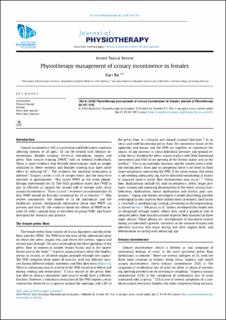| dc.contributor.author | Bø, Kari | |
| dc.date.accessioned | 2020-08-31T09:07:48Z | |
| dc.date.available | 2020-08-31T09:07:48Z | |
| dc.date.created | 2020-08-05T13:33:53Z | |
| dc.date.issued | 2020 | |
| dc.identifier.citation | Journal of Physiotherapy. 2020, 66(3), 147-154. | en_US |
| dc.identifier.issn | 1836-9553 | |
| dc.identifier.uri | https://hdl.handle.net/11250/2675640 | |
| dc.description | This is an open access article under the CC BY-NC-ND license (http://creativecommons.org/ licenses/by-nc-nd/4.0/). | en_US |
| dc.description.abstract | Urinary incontinence (UI) is a prevalent and bothersome condition affecting women of all ages. UI can be treated with lifestyle interventions, bladder training, electrical stimulation, surgery and pelvic floor muscle training (PFMT) with or without biofeedback. There is some evidence that lifestyle interventions (such as weight reduction in obese women) and bladder training may have some effect in reducing UI. The evidence for electrical stimulation is debated. Surgery carries a risk of complications and the long-term outcome is questionable. This leaves PFMT as the main physiotherapy intervention for UI. The NICE guideline states that PFMT is just as effective as surgery for around half of women with stress urinary incontinence. There is Level 1 evidence (recommendation A) that PFMT should be first-line treatment for UI in females. This review summarises: the burden of UI for individuals and the healthcare system; background information about how PFMT can prevent and treat UI; the evidence about the effects of PFMT on female UI, with a special focus of the effect of group PFMT; and future directions for research and practice. | en_US |
| dc.language.iso | eng | en_US |
| dc.subject | incontinence | en_US |
| dc.subject | physical therapy | en_US |
| dc.subject | females | en_US |
| dc.subject | pelvic floor muscles | en_US |
| dc.subject | pelvic floor exercises | en_US |
| dc.title | Physiotherapy management of urinary incontinence in females | en_US |
| dc.type | Peer reviewed | en_US |
| dc.type | Journal article | en_US |
| dc.description.version | publishedVersion | en_US |
| dc.rights.holder | © 2020 Australian Physiotherapy Association | en_US |
| dc.source.pagenumber | 147-154 | en_US |
| dc.source.volume | 66 | en_US |
| dc.source.journal | Journal of Physiotherapy | en_US |
| dc.source.issue | 3 | en_US |
| dc.identifier.doi | 10.1016/j.jphys.2020.06.011 | |
| dc.identifier.cristin | 1821818 | |
| dc.description.localcode | Institutt for idrettsmedisinske fag / Department of Sports Medicine | en_US |
| cristin.ispublished | true | |
| cristin.fulltext | original | |
| cristin.qualitycode | 1 | |
